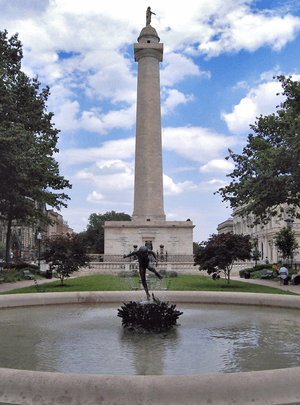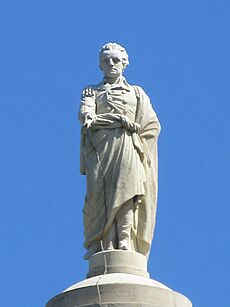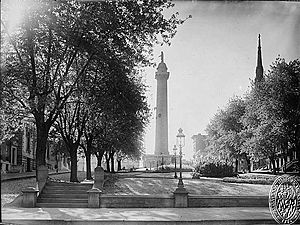Washington Monument (Baltimore) facts for kids

The Washington Monument in Baltimore
|
|
| Coordinates | 39°17′51″N 76°36′57″W / 39.29750°N 76.61583°W |
|---|---|
| Location | Baltimore, Maryland, United States |
| Designer | Robert Mills |
| Type | Colossal Doric column |
| Material | White marble |
| Height | 178 feet 8 inches (54.46 m) |
| Beginning date | 1815 |
| Completion date | 1829 |
| Opening date | 1815 [site visitation] |
| Dedicated to | George Washington |
The Washington Monument in Baltimore, Maryland, is a famous landmark. It stands in the middle of Mount Vernon Place, a beautiful city square. This monument was the very first major structure built to honor George Washington (1732–1799). He was a hero of the American Revolutionary War and the first President of the United States.
Contents
History of the Monument
Building the First Washington Monument
The monument was designed by Robert Mills, a talented American architect. He also designed the much taller Washington Monument in Washington, D.C., many years later. Construction of the Baltimore monument started in 1815. It was built on land given by Colonel John Eager Howard, a local hero. The main stone work was finished by 1829.
The monument is a huge column, about 178 feet (54 meters) tall. Inside, there's a gallery with digital exhibits. These exhibits teach you about the monument's construction and the life of George Washington. You can also learn about the Mount Vernon neighborhood. If you climb the 227 steps to the top, you get an amazing view of Baltimore!
Why Build a Monument to Washington?
People wanted to honor George Washington even before he passed away in 1799. After his death, the idea of a memorial became even stronger. Baltimore, a growing city at the time, was eager to build a tribute. In 1807, the idea for a monument was first suggested. A group of citizens formed in 1809 to make it happen.
To raise money, the state of Maryland allowed a lottery in 1810. In 1813, a competition was held to find the best design. Robert Mills won with his plan in 1814. He was proud to be the first American-born architect with formal training.
Choosing the Design and Location
Mills's first design was very fancy, with many decorations and balconies. It even showed Washington riding in a chariot at the top! But this design was too expensive and very tall. People living near the planned site worried it might fall on their homes.
So, a new location was chosen: Howard's Woods, north of the city. Colonel John Eager Howard donated the land. By the time the first stone was laid on July 4, 1815, Mills had made the design much simpler. The final column looks a lot like the Colonne Vendôme in Paris, France. This style was popular during a time called Neoclassicism in American architecture.
The Cornerstone Ceremony
The laying of the cornerstone was a very important event. James Buchanan, the head of the monument's board, spoke at the ceremony. He said Baltimore was special for being the first city to honor Washington. He also noted that Baltimore had successfully defended itself against the British in the Battle of Baltimore the year before.
The ceremony declared that the monument would remind everyone of the good things Washington did for the country. Levin Winder, the Governor of Maryland, officially laid the cornerstone. The event was so important that it was printed in newspapers and a special booklet.
Early Visitors to the Monument
Even while it was being built, the monument was a popular spot. In 1817, President James Monroe visited the site. People were allowed to explore the monument, even inside. By 1820, visitors were already climbing the stairs to the top. A newspaper editor from New York, Nathaniel H. Carter, climbed it in 1823. He enjoyed the city views from the top.
Materials and the Statue
The monument is made of white marble from three different quarries in Baltimore County, Maryland. The base, column, and the statue each came from a different source.
At the very top of the column stands a statue of George Washington. It shows him resigning his position as Commander-in-Chief of the Continental Army. This important event happened in Annapolis, Maryland, in 1783. By stepping down, Washington showed that he believed in civilian rule, not military power.

The statue was carved by Enrico Causici, an Italian sculptor. A fun story says that when the statue was placed on top in 1829, a shooting star appeared. An eagle also supposedly landed on Washington's head!
Later Additions and Importance
In the 1830s, bronze plaques were added to the monument. They list eight important events from Washington's life. Former President John Quincy Adams helped choose the words for these plaques. A cast-iron fence, also designed by Mills, was added around the base in 1838. It has symbols representing Maryland and the original thirteen colonies.
Other monuments to Washington were built later, like the one in Washington Monument State Park in Maryland. The famous Washington Monument in Washington, D.C., started in 1848 but wasn't finished until 1885. Because of this, the Baltimore Washington Monument was the main symbol of American pride for George Washington for many years.
The monument is still open for visitors today.
Lighting of the Washington Monument
Since 1971, Baltimore has celebrated the "Lighting of the Washington Monument." This event happens every year on the first Thursday in December. Before the lighting, a holiday village is set up in Mount Vernon Place. The monument is lit up, usually followed by a fireworks show. The holiday lights stay on until after Christmas Day. In 2020, due to the COVID-19 pandemic, the lighting ceremony was held online.
Restoration and Discoveries
Monument Restoration Project
In June 2010, the monument was closed for safety reasons. There were concerns about missing mortar and rusted support parts. A car accident in October 2010 also damaged the fence. It was decided that the monument needed a full renovation.
In 2012, the City of Baltimore teamed up with the Mount Vernon Place Conservancy. They worked together to restore, maintain, and manage the monument and its surrounding parks. A big $5.5 million restoration project began in January 2014. The monument reopened on July 4, 2015. This celebrated 200 years since its cornerstone was first laid.
Time Capsules Found!
During the restoration, two amazing time capsules were discovered! One was the monument's original 1815 cornerstone. The other was a 1915 Centennial time capsule, which people had forgotten about.
The 1915 time capsule was found first in October 2014. It was a sealed copper box hidden behind a plaque. It had been placed there during the monument's 100th anniversary celebration.
In February 2015, workers found the 1815 cornerstone. It contained three glass jars filled with newspapers from July 1 and July 3, 1815. The cornerstone also had a carved panel and likely other items like coins. Both time capsules' contents were taken to the Walters Art Museum for study.
On June 2, 2015, the contents of both time capsules were revealed. The 1815 cornerstone held a copy of the United States Declaration of Independence. It was printed in a Baltimore newspaper on July 3, 1815. This shows that the monument was not just for George Washington. It was also an early American monument celebrating the nation's independence.
You can see the items from both time capsules at the Maryland Center for History and Culture. It's just two blocks from the monument!
Historic Landmark Status
The Washington Monument is the main feature of Mount Vernon Place. This area is so important that it was named a National Historic Landmark District in 1971. It's also part of the Baltimore National Heritage Area.
See also
- List of memorials to George Washington
- List of statues of George Washington
- List of public art in Baltimore
- List of statues
- List of sculptures of presidents of the United States
- List of tallest structures built before the 20th century
- Presidential memorials in the United States
- Washington Monument State Park



